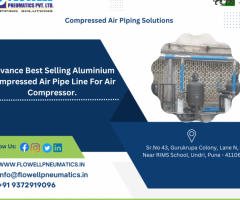The inclusion of a moisture tap in compressed air piping systems offers several benefits, contributing to the overall efficiency and reliability of the system.
Moisture Control: A moisture tap helps in effective moisture control within the compressed air piping system. Moisture is a common by product of compressed air, and if left unmanaged, it can cause corrosion, damage pneumatic equipment, and negatively impact the overall system performance. By installing a moisture tap at strategic points, operators can regularly drain accumulated moisture, ensuring a dry and clean compressed air supply.
Enhanced System Efficiency: The presence of moisture in compressed air can lead to increased pressure drop, decreased ...
The inclusion of a moisture tap in compressed air piping systems offers several benefits, contributing to the overall efficiency and reliability of the system.
Moisture Control: A moisture tap helps in effective moisture control within the compressed air piping system. Moisture is a common by product of compressed air, and if left unmanaged, it can cause corrosion, damage pneumatic equipment, and negatively impact the overall system performance. By installing a moisture tap at strategic points, operators can regularly drain accumulated moisture, ensuring a dry and clean compressed air supply.
Enhanced System Efficiency: The presence of moisture in compressed air can lead to increased pressure drop, decreased flow rates, and reduced system efficiency. By utilizing a moisture tap, operators can proactively remove accumulated moisture, minimizing the potential for blockages and pressure losses. This, in turn, allows the system to operate at optimal performance levels, maximizing productivity and energy efficiency.
Equipment Protection: Moisture can be detrimental to pneumatic equipment and tools. It can cause rusting, corrosion, and clogging of internal components, leading to premature wear and damage. By incorporating a moisture tap, operators can prevent these issues by regularly draining the moisture from the system, ensuring the longevity and reliable operation of equipment and tools.
Maintenance Optimization: Installing a moisture tap simplifies the maintenance process of the compressed air piping system. Regular draining of accumulated moisture helps prevent the buildup of contaminants, such as rust particles and oil residue, within the system. This reduces the frequency of system maintenance requirements, minimizing downtime and associated costs.
Quality Compressed Air Supply: Moisture-free compressed air is essential for applications where air quality is critical, such as in food and beverage processing, pharmaceutical production, and precision manufacturing. A moisture tap facilitates the removal of excess moisture, ensuring a clean and dry compressed air supply, meeting the stringent quality requirements of such applications.
Longevity of Piping System: Excessive moisture within the compressed air piping system can accelerate corrosion and deterioration of the piping materials. By effectively managing moisture through a moisture tap, the longevity of the system can be significantly improved. This reduces the need for frequent repairs or replacements, resulting in long-term cost savings and enhanced system reliability.
In summary, incorporating a moisture tap in compressed air piping systems, manufactured by reputable Compressed Air Piping Manufacturers, including Aluminium Compressed Air Piping Manufacturers, helps control moisture levels, enhances system efficiency, protects equipment, optimizes maintenance processes, ensures high-quality air supply, and extends the lifespan of the piping system. These benefits contribute to overall operational efficiency and cost-effectiveness in industrial settings, where reliable and dry compressed air is essential.



